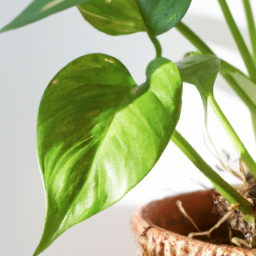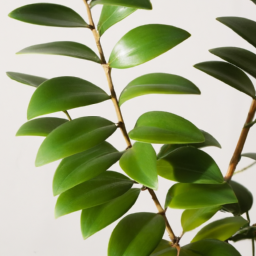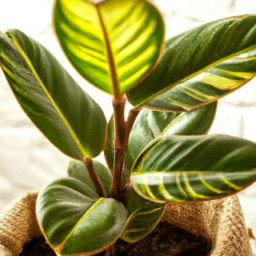
If you’re on the hunt for some unique indoor plants starting with X to add to your collection, you’ve come to the right place! Finding plants that begin with this letter may seem like a challenge, but there are actually several stunning options to choose from. Whether you’re looking for a new addition to your home or office space, these X-named plants are sure to bring a touch of greenery and beauty to any room. Let’s explore some of the top indoor plants starting with X that you can consider adding to your indoor garden.
Xanadu Plant Care Tips for Indoor Gardening
Introduction
Xanadu plants, also known as Philodendron Xanadu, are popular indoor plants that can add a touch of tropical elegance to any space. With their lush, green foliage and easy care requirements, Xanadu plants are a great choice for beginner indoor gardeners. In this guide, we will provide you with all the tips and tricks you need to successfully care for your Xanadu plant and help it thrive in your indoor space.
Lighting
When it comes to caring for your Xanadu plant, one of the most important factors to consider is lighting. Xanadu plants thrive in bright, indirect light, so it’s important to place them in a spot where they will receive plenty of natural light throughout the day. Avoid placing your Xanadu plant in direct sunlight, as this can scorch the leaves and cause them to turn yellow. If you notice that your Xanadu plant is not getting enough light, you can supplement with a grow light to help it thrive.
In addition to proper lighting, it’s also important to rotate your Xanadu plant regularly to ensure that all parts of the plant receive equal amounts of light. This will help prevent the plant from becoming lopsided or leggy and will promote even growth throughout.
Another important aspect of lighting for your Xanadu plant is to avoid sudden changes in light levels. If you need to move your plant to a new location, do so gradually to allow the plant to acclimate to its new surroundings and prevent shock.
Watering and Humidity
Proper watering is crucial for the health of your Xanadu plant. These plants prefer to be kept consistently moist but not waterlogged, so it’s important to water them regularly and ensure that the soil is well-draining. Allow the top inch of soil to dry out between waterings, and be sure to water your Xanadu plant thoroughly each time to ensure that the roots receive adequate moisture.
In addition to proper watering, Xanadu plants also benefit from increased humidity levels. To increase humidity around your plant, you can mist the leaves regularly, place a humidifier nearby, or group your plants together to create a microclimate of higher humidity. This will help prevent the tips of the leaves from turning brown and keep your Xanadu plant looking lush and healthy.
It’s also important to avoid overwatering your Xanadu plant, as this can lead to root rot and other issues. If you notice that the leaves are turning yellow or wilting, it may be a sign that you are watering your plant too much. Adjust your watering schedule accordingly and allow the soil to dry out slightly between waterings.
In conclusion, caring for your Xanadu plant is a rewarding experience that can bring a touch of tropical beauty to your indoor space. By following these tips and providing your plant with the proper lighting, watering, and humidity levels, you can ensure that your Xanadu plant thrives and continues to brighten up your home for years to come.

Xerophyllum Tenax: A Unique Indoor Plant for Your Home
If you are looking for a unique and eye-catching indoor plant to add to your home, look no further than Xerophyllum Tenax. This stunning plant, also known as bear grass or Indian basket grass, is a native plant of North America and is sure to make a statement in any room.
The Beauty of Xerophyllum Tenax
Xerophyllum Tenax is a striking plant with long, slender leaves that can grow up to three feet in length. The leaves are a vibrant green color and have a unique texture that adds visual interest to any space. In the spring and summer, Xerophyllum Tenax produces delicate white flowers that add a touch of elegance to the plant.
One of the great things about Xerophyllum Tenax is that it is relatively low-maintenance and can thrive in a variety of indoor environments. This makes it an ideal plant for beginners or for those who may not have a green thumb. With the right care, Xerophyllum Tenax can add beauty and charm to your home for years to come.
To care for your Xerophyllum Tenax, be sure to place it in a location where it will receive plenty of bright, indirect sunlight. Water the plant when the top inch of soil feels dry to the touch, and be sure to avoid overwatering, as this can lead to root rot. Additionally, be sure to fertilize your Xerophyllum Tenax every few months to promote healthy growth.
Benefits of Xerophyllum Tenax
In addition to its beauty, Xerophyllum Tenax offers a number of benefits for your home. Indoor plants have been shown to improve air quality by removing toxins from the air and releasing oxygen. Xerophyllum Tenax is no exception, and can help to create a healthier indoor environment for you and your family.
Furthermore, having indoor plants like Xerophyllum Tenax in your home can help to reduce stress and improve your overall well-being. Studies have shown that being around plants can help to lower blood pressure, reduce anxiety, and improve mood. By adding Xerophyllum Tenax to your home, you can create a peaceful and relaxing atmosphere that promotes health and happiness.
In addition to its health benefits, Xerophyllum Tenax can also add a touch of style and sophistication to your home decor. Whether you place it in a sleek, modern pot or a rustic, vintage container, Xerophyllum Tenax is sure to enhance the aesthetic of any room. Its unique appearance and striking foliage make it a standout choice for those looking to add a touch of nature to their home.
Tips for Growing Xerophyllum Tenax
If you are considering adding Xerophyllum Tenax to your indoor plant collection, there are a few tips to keep in mind to ensure that your plant thrives. First, be sure to choose a well-draining potting mix for your Xerophyllum Tenax, as this will help to prevent waterlogged soil and root rot. Additionally, be sure to repot your plant every few years to refresh the soil and provide room for growth.
When watering your Xerophyllum Tenax, be sure to water deeply and allow the excess water to drain away. This will help to prevent water from pooling at the bottom of the pot and causing root rot. Finally, be sure to keep an eye out for any signs of pests or disease, and treat your plant promptly if any issues arise.
In conclusion, Xerophyllum Tenax is a unique and beautiful indoor plant that is sure to add charm and elegance to your home. With its striking foliage, delicate flowers, and low-maintenance care requirements, Xerophyllum Tenax is an ideal choice for both beginners and experienced plant enthusiasts. By following the tips outlined in this article, you can enjoy the beauty and benefits of Xerophyllum Tenax in your home for years to come.

Xerographica Air Plant: A Low-Maintenance Indoor Plant Option
About Xerographica Air Plants
Xerographica air plants, also known as Tillandsia xerographica, are a popular choice for indoor plant enthusiasts due to their unique appearance and low-maintenance requirements. These plants are native to Central America and Mexico, where they can be found growing on trees and rocks. Xerographica air plants are epiphytes, meaning they absorb nutrients and water through their leaves rather than roots, making them a great option for those looking for a plant that requires minimal care.
One of the most striking features of the xerographica air plant is its silvery-green leaves, which curl and twist in an elegant rosette shape. These plants can grow to be quite large, with some reaching sizes of up to 3 feet in diameter. Xerographica air plants are also known for their long-lasting blooms, which can last for several weeks and add a pop of color to any indoor space.
How to Care for Xerographica Air Plants
When it comes to caring for xerographica air plants, the key is to provide them with the right environment and minimal maintenance. These plants thrive in bright, indirect light, so be sure to place them near a window where they can receive plenty of sunlight. It’s also important to mist your xerographica air plant with water a few times a week to keep it hydrated, especially in dry indoor environments.
In addition to regular misting, xerographica air plants can benefit from a monthly soak in water to ensure they are getting enough moisture. To do this, simply fill a bowl with room temperature water and submerge the plant for about 20-30 minutes. After soaking, be sure to shake off any excess water and allow the plant to dry completely before returning it to its display area.
Displaying Xerographica Air Plants in Your Home
Xerographica air plants are versatile when it comes to displaying them in your home. These plants can be mounted on driftwood or placed in decorative containers to create a unique and eye-catching display. You can also hang xerographica air plants from macrame hangers or display them in terrariums for a modern and stylish look.
When it comes to choosing a location for your xerographica air plant, keep in mind that they prefer warm, humid environments. Avoid placing them near air vents or drafty windows, as this can cause the plant to dry out quickly. With the right care and attention, xerographica air plants can thrive indoors and add a touch of natural beauty to your living space.
Key Takeaways
Today, let’s talk about indoor plants that start with the letter X. While it may seem like a challenging task to find plants that fit this criteria, there are actually a couple of options that can thrive in your home. One popular choice is the Xanadu Philodendron, a tropical plant known for its lush, green foliage and easy care requirements. This plant is perfect for adding a touch of greenery to any room and can tolerate low light conditions, making it a versatile choice for indoor spaces.
Another indoor plant that starts with X is the Xerosicyos danguyi, also known as the Silver Dollar Vine. This unique succulent features round, silver-green leaves that resemble coins, adding a fun and quirky element to your indoor garden. The Silver Dollar Vine is a low-maintenance plant that thrives in bright, indirect light and requires minimal watering, making it a great choice for beginner plant enthusiasts. So if you’re looking to add a new plant to your indoor collection, consider adding a Xanadu Philodendron or a Silver Dollar Vine to bring some greenery and personality to your home.
Here are this week’s Top Questions and Answers
Q1. What are some indoor plants that start with the letter X?
A1. One popular indoor plant that starts with the letter X is the Xanadu Philodendron. This plant has large, glossy leaves and is easy to care for, making it a great addition to any indoor space.
Q2. Are there any other indoor plants that begin with the letter X?
A2. Another indoor plant that starts with the letter X is the Xerographica Air Plant. This unique plant does not require soil to grow and can thrive in a variety of indoor environments.
Q3. What are some characteristics of indoor plants that start with X?
A3. Indoor plants that start with the letter X often have exotic-sounding names and unique features. They can range from leafy plants like the Xanadu Philodendron to air plants like the Xerographica.
Q4. How can I care for indoor plants that start with X?
A4. To care for indoor plants that start with X, make sure to provide them with the appropriate amount of light, water, and humidity. Regularly dusting their leaves and checking for pests can also help keep them healthy.
Q5. Where can I find indoor plants that start with X?
A5. You can find indoor plants that start with the letter X at your local plant nursery, garden center, or online plant retailers. Be sure to check the specific care instructions for each plant to ensure it thrives in your indoor space.
Dr. Olivia Green is a botanist with over two decades of experience in indoor plant cultivation. She holds a Ph.D. in Plant Biology and has dedicated her career to researching plant behavior in controlled environments. Dr. Green is passionate about helping plant enthusiasts master the art of indoor gardening through her extensive knowledge and practical insights.


